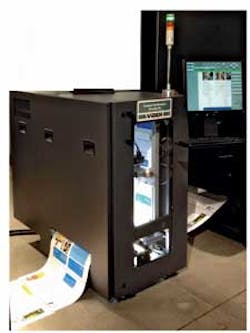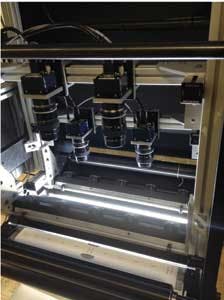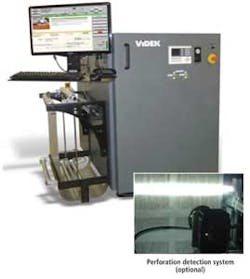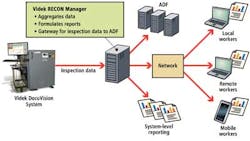Machine vision system makes light of high-speed printing inspection
Larry Willoughby
Organizations in finance, insurance, healthcare, government and utilities are all tasked with delivering printed communications to their customers accurately and on-schedule. These document services organizations - whether they be a corporate in-plant team or a print-for-pay service bureau - produce, print and mail personal credit card statements, explanation of benefits (EOBs), negotiable documents and investment summaries.
With the introduction of high-speed inkjet technology, color now provides an exciting new dimension to printed materials. Promotional offerings can be added to these transactional documents delivering personalized campaigns to individual customers. This is a powerful marketing strategy because transactional documents are typically opened and read as they contain customer-critical information.
With the speeds of these new digital color inkjet printers it is difficult to monitor the overall quality of the output. To add to the challenge, new supporting paper handling equipment is often used. Previously, paper would be fed into a printer, printed and stacked into folds where it could be manually inspected by an operator. Now the printed paper is rewound onto a paper handling device at speeds up to 1000 ft per minute and beyond, further limiting visual manual inspection.
Hence, these organizations are now faced with the challenge of inspecting full color documents containing variable, personalized information to ensure that the quality of the printed documents meet the needs of their customers.
Inspecting the image
To help such document services organizations address these quality control issues, engineers at Videk (Fairport, NY, USA; www.videk.com) have developed a vision-based inspection system specifically for the task (Figure 1).
The DocuVision 8600 inline system inspects full pages of colored printed material in real time and at high speed to verify the print quality of the pages and the integrity of the data printed on them. The system can be integrated directly into printers from Canon-Océ (Melville, NY, USA; www.usa.canon.com), Kodak (Rochester, NY, USA; www.kodak.com), Pitney Bowes (Stamford, CT, USA; www.pb.com), Hewlett Packard (Palo Alto, CA; www.hp.com), Xerox (Norwalk, CT, USA; www.xerox.com) and Ricoh (Malvern, PA, USA; www.ricoh-usa.com), or can be placed downstream from a printer via a custom designed transportation stand designed by Videk and manufactured by EMT International (Hobart, WI, USA; www.emtinternational.com).
To inspect printed materials for errors and defects as they move continuously along a web at speeds up to 200 ins/s, DocuVision captures images of each printed document at a resolution of 200 dpi using up to four Piranha4 4k color line-scan cameras from Teledyne DALSA (Waterloo, ON, Canada; www.teledynedalsa.com) that feature 4096 x 3 pixels, a 10 µm pixel size and a maximum line rate of 70 kHz.
Most lenses available today feature automatic focus and aperture and optimized for the smaller frame size of digital cameras. However, for the DocuVision 8600 system, Videk chose to fit the cameras with F-mount 55mm manual focus lenses from Nikon (Tokyo, Japan; www.nikon.com) which are situated two feet above the web along which the printed material travels (Figure 2).
The number of cameras deployed in the system depends on the width of the web and the resolution of the image that is demanded by the application. A single 4k camera for example, might be appropriate to capture images from a 20in web at 200 dpi resolution, while a wider 42in web would require the use of two cameras to capture images at the same resolution.
Images captured from the line-scan cameras are streamed over a Camera Link interface to either a PC-based Karbon or Neon frame grabber from BitFlow (Woburn, MA, USA; www.bitflow.com), depending upon how many cameras are used. The frame grabber buffers the individual lines from the camera, reformats them as complete images and transfers the image data over a PCI Express bus interface directly into the memory of the PC. There, they can be accessed by the DocuVision print inspection software for analysis.
To illuminate the web of paper, Videk worked with Metaphase Technologies (Bristol, PA, USA; www.metaphase-tech.com) to develop a custom lighting solution mounted in the optical pathway of the camera. While conventional line lights illuminate a web from an angle, the approach has the disadvantage that angled light can create shadows on slightly rippled paper, with the result that any images captured cannot easily be analyzed. Metaphase resolved this issue by projecting LED light onto the surface of a dome, which then reflects diffuse light directly back onto the web of paper through a slotted aperture.
Most applications using line scan imaging require synchronization between the moving object and the camera, and the DocuVision 8600 print inspection system is no exception. By synchronizing the two, the system ensures that the geometry of the image will remain constant even as the speed of the web changes. In addition, the system must accurately identify a "top of form" position mark on each page which indicates the position at which the printer started printing onto the page. Once the mark is identified, it is used as a trigger to initiate the capture of images from the line-scan camera.
The line rates of the Piranha4 4k line-scan cameras are determined through the use of an incremental encoder that is coupled to a drive unit on the web. Data from the encoder is transferred to a proprietary set of hardware external to the PC dubbed PageVision, which was developed to handle all the I/O signals required for the interface between the DocuVison software and the printer hardware. The "top of form" position mark, on the other hand, is detected by a small spot laser reflective sensor which also transfers the data indicating the start of the document to the same PageVision module.
Once acquired, the PageVision system feeds both sets of data into the PC host over a serial connection which it uses to dynamically adjust the line rate of the cameras and determine when the cameras should be triggered to start to capture images. The captured images are then analyzed by the DocuVision software.
Aside from capturing and analyzing data on documents, the DocuVision 8600 system can be optionally fitted with additional lighting and cameras to detect variably-placed perforations in documents, such as those that contain a check attached to printed material (Figure 3).
The perforation detection system backlights the perforation on the document with a line light from Metaphase and captures images of the light that passes through the perforation using one or two Teledyne DALSA 4k monochrome line-scan cameras. The perforation images have a dark background with a white foreground where light has passed through the holes in the perforated paper. The data from the perforation detection camera(s) is also transferred to the PC over a Camera Link interface to a frame grabber, formatted and passed to the PC where it too can be analyzed by the DocuVision print inspection software.
During an inspection cycle, the images from all the cameras (both those performing regular inspection tasks and detecting the perforation) are all processed and displayed to the operator simultaneously. Therefore, any quality defects, whether they are missing perforations or non-readable bar codes, can be detected and either highlighted to an operator or flagged to stop the printer.
Software verification
Despite their obvious advantages, the widespread deployment of inkjet printers has placed a new set of demands on manufacturers of automated image verification systems. Besides checking documents for the accuracy of the data printed on them, the image processing software must perform a range of additional functions.
Written in C and running under a real-time Linux OS, the DocuVision color print verification software uses a number of different software algorithms for identifying features on pages of printed material. The specific modules for a particular job are chosen through a configuration utility when the system is commissioned at a specific printing house.
One feature of the system is its ability to determine whether any errors on the page have been created by a printer whose ink jets have become stuck on or off due to clogging. Jets that stick on cause streaking resulting in a continuous line page after page while jets that become clogged can cause a color to drop out or result in voids in page content.
Since most modern documents are printed in color, the software also measures the correctness of the color on the paper. Brand-essential colors such as those found in a corporate logo, can be trained into the system and subsequently monitored for the entire print job when each document is analyzed. In addition, the software can be set up to read 2D bar codes, linear bar codes, and postal codes, and perform optical character recognition (OCR) to ensure that the printed documents contain accurate information.
DocuVision also checks the registration of the cyan, magenta, yellow and black (CMYK) color planes by inspecting a test element such as a crosshair. If a color moves out of register, the vision system identifies the problem and which color has moved. No less important is the measurement of the registration of the print itself either in the vertical or horizontal direction, which can be resolved to an accuracy of 0.005ins.
One of the most important attributes of the software, however, is its ability to perform conditional execution, or executing a sequence of inspection routines on a document based on the artifacts that are found on the document. In that way, printed documents comprising a number of different pages can be inspected in a custom fashion according to the nature of the material printed on them.
Each document inspected by the system can be tagged as having passed or failed any given vision inspection task. This data can be used to trigger the system to produce a visual indicator on a display screen to alert an operator (Figure 4) or to sound an alarm.
If the system detects a catastrophic error in the printing process, it can also stop one or more of the printers, eliminating the expenditure of further paper, ink and production time. To do so, the DocuVision software delivers an instruction to halt the printer to the external PageVision module which communicates the instruction to the printer over an optically isolated output.
Tagged and tracked
When combined with Videk's ReCon Manager data collection and reporting software tool, the 8600 system can also collect and store data relating to the print quality and document data fields (such as check amounts) on an SQL-based database.
To do so, ReCon Manager software accepts the inspection results passed to it by the DocuVision system over an Ethernet connection. A data handshake protocol between the two enables the DocuVision system to be aware that the data collection system is connected and will alert the operator via a warning on screen if the connection is lost.
ReCon Manager compiles all data on the inspections performed by the DocuVision system, and generates production reports based on customer-specified requirements. It allows networked access - either on-site, remote or mobile - to the production information and serves as a gateway for inspection data to be communicated to higher-level Automated Document Factory (ADF) systems via Videk's ADF Bridge module (Figure 5).
Common reporting applications include the identification of missing or duplicate documents, the tallying of the total amounts of check print jobs and comparison with intended production totals. The system can also track color quality tolerances, streaks or voids and bar code quality. Up to eight DocuVision systems can be supported through a single Recon manager system, enabling reports to be consolidated from multiple print lines into a single access point.
Larry Willoughby, Applications and Service Engineer, Videk (Fairport, NY, USA; www.videk.com)
Companies mentioned
BitFlow
Woburn, MA, USA
www.bitflow.com
Canon-Océ
Melville, NY, USA;
www.usa.canon.com
EMT International
Hobart, WI, USA
www.emtinternational.com
Hewlett Packard
Palo Alto, CA, USA
www.hp.com
Kodak
Rochester, NY, USA
www.kodak.com
Metaphase Technologies
Bristol, PA, USA
www.metaphase-tech.com
Pitney Bowes
Stamford, CT, USA
www.pb.com
Ricoh
Malvern, PA, USA
www.ricoh-usa.com
Teledyne DALSA
Waterloo, ON, Canada
www.teledynedalsa.com
Videk
Fairport, NY, USA
www.videk.com
Xerox
Norwalk, CT, USA
www.xerox.com
Vision Systems Articles Archives





